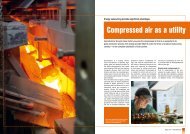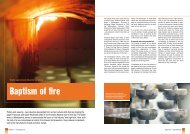History and Mystery: Easter Island
History and Mystery: Easter Island
History and Mystery: Easter Island
You also want an ePaper? Increase the reach of your titles
YUMPU automatically turns print PDFs into web optimized ePapers that Google loves.
Rapa Nui: Best known for the giant stone monoliths that<br />
dot the coastline, this mysterious isle at the end of the<br />
earth has long been the subject of curiosity <strong>and</strong> speculation.<br />
With its turbulent past, Rapa Nui is now looking to a<br />
bright future in tourism <strong>and</strong> a Kaeser compressor is helping<br />
to preserve its greatest attractions.<br />
Whether the first settlers on Rapa Nui<br />
(<strong>Easter</strong> Isl<strong>and</strong>) arrived in 500, 900 or<br />
1200 A.D. is open to debate, but one<br />
thing is for certain: they had travelled a<br />
very long way. The nearest human<br />
habitation lies 2200 kilometres to the<br />
west on the isl<strong>and</strong> of Pitcairn, which today<br />
is home to the descendents of mutineers<br />
from the ill-fated British navy<br />
ship the Bounty. What‘s more, Chile –<br />
Rapa Nui‘s mother country – is situated<br />
3000 kilometres to the east. Rapa Nui<br />
is therefore one of the most isolated inhabited<br />
isl<strong>and</strong>s in the world, yet still<br />
captures the imagination of people on<br />
every continent. This is due in great<br />
part to its past, much of which remains<br />
a mystery. Approximately 900 large<br />
stone statues, or Moai, have been an<br />
integral part of the <strong>Easter</strong> Isl<strong>and</strong> l<strong>and</strong>scape<br />
for many centuries. The Norwegian<br />
anthropologist Thor Heyerdahl led<br />
the first archaeological expedition to<br />
<strong>Easter</strong> Isl<strong>and</strong> in 1955 <strong>and</strong> shed light on<br />
how these Moai were created from volcanic<br />
rock in the Rano Raraku volcanic<br />
crater <strong>and</strong> how they were subsequently<br />
transported to their large stone platforms,<br />
or Ahu. The isl<strong>and</strong> was once<br />
covered by a forest of palms <strong>and</strong> it is<br />
now believed that native <strong>Easter</strong> Isl<strong>and</strong>ers<br />
deforested the isl<strong>and</strong> in the process<br />
of erecting <strong>and</strong> mass-producing their<br />
statues, as this task would have required<br />
a large number of tree trunks for<br />
the rolling <strong>and</strong> lifting procedures that<br />
would have been involved. This dramatic<br />
depletion of the isl<strong>and</strong>‘s natural<br />
resources lead to a serious food shortage,<br />
as did the various feuds which<br />
consequently broke out amongst different<br />
factions of the Rapa Nui – the term<br />
refers to the people as well as the l<strong>and</strong><br />
<strong>and</strong> language. Needless to say, the isl<strong>and</strong>‘s<br />
population went into rapid decline:<br />
At its peak, the population may<br />
have been as high as 15,000, but when<br />
Dutch navigator Jacob Roggeveen<br />
“discovered” the isl<strong>and</strong> on 5 April 1722<br />
(<strong>Easter</strong> Sunday – hence the isl<strong>and</strong>‘s<br />
name) only a couple of thous<strong>and</strong> inhabitants<br />
remained. After the Dutch,<br />
came the Spanish, albeit 48 years later<br />
in 1770. After the flying visit by British<br />
explorer James Cook in 1774, visits to<br />
the isl<strong>and</strong> became more frequent <strong>and</strong><br />
increasingly unpleasant for the inhabitants:<br />
The Rapa Nui soon became acquainted<br />
with the harsh ways of the<br />
“civilised world” when the crews of two<br />
Photo: Norberto Seebach/CPT Chile<br />
Berlin-based Maar Denkmalpflege GmbH has been dedicated to the preservation<br />
<strong>and</strong> restoration both of national <strong>and</strong> international cultural monuments for many years.<br />
The company‘s references, amongst others, include Aachen Cathedral, the Reichstag<br />
<strong>and</strong> Olympic Stadium in Berlin, as well as the Walhalla Temple near Regensburg. On<br />
the 13th October 2003, UNESCO rewarded the company‘s outst<strong>and</strong>ing contribution<br />
towards the Preservation of World Heritage by making Maar Denkmalpflege GmbH a<br />
UNESCO recognised partner.<br />
<strong>History</strong> <strong>and</strong> <strong>Mystery</strong>: <strong>Easter</strong> Isl<strong>and</strong><br />
Photo: George Mundo/CPT Chile<br />
12<br />
Report 2/07 – www.kaeser.com
Photo: Maar<br />
US-American ships forced many inhabitants<br />
into work <strong>and</strong> ran amok on the<br />
isl<strong>and</strong>. Things became even worse after<br />
1855, as over a third of the population<br />
of 4500 people was taken to Peru<br />
<strong>and</strong> enslaved. International protests<br />
erupted <strong>and</strong> the slaves were finally<br />
freed. Finally, a few isl<strong>and</strong>ers managed<br />
to return from the horrors of Peru, but<br />
brought back typhus, which soon infected<br />
the remaining population. A further<br />
1000 inhabitants died as a result.<br />
By the time the first Christian missionaries<br />
came to the isl<strong>and</strong> in 1854, the<br />
old culture had disappeared, as had all<br />
semblance of society – 23 years later,<br />
there were just 111 people living on<br />
<strong>Easter</strong> Isl<strong>and</strong>. The isl<strong>and</strong> was annexed<br />
by Chile in 1888 after its inhabitants<br />
signed a treaty with the Chilean government.<br />
Until the 1960s, the surviving<br />
Rapa Nui descendants were forced to<br />
live in a settlement, as the isl<strong>and</strong> was<br />
rented to a Scottish sheep company. In<br />
1965, Alfonso Rapu led an insurrection<br />
that forced the Chilean government to<br />
return rights to the l<strong>and</strong> <strong>and</strong> its precious<br />
archaeological treasures to the Rapa<br />
Nui. Alfonso Rapu also became the<br />
first Rapa Nui to be elected mayor of<br />
the isl<strong>and</strong>. Since being given Chilean<br />
citizenship in 1966, the isl<strong>and</strong>ers have<br />
re-embraced their ancient culture, or<br />
what could be reconstructed of it. <strong>Easter</strong><br />
Isl<strong>and</strong>‘s population now st<strong>and</strong>s at<br />
approximately 4000 with the native<br />
Rapa Nui accounting for just over half<br />
of this figure. The airfield at Mataveri<br />
was completed in 1967 <strong>and</strong> was lengthened<br />
by NASA in the 1970‘s to serve<br />
as an alternate emergency-l<strong>and</strong>ing site<br />
for the space shuttle. Consequently, as<br />
large passenger flights are able to l<strong>and</strong><br />
at Rapa Nui, tourists come from far <strong>and</strong><br />
wide to visit <strong>and</strong> explore this remote<br />
part of the world, which became a<br />
UNESCO World Heritage Site in 1995.<br />
The majority of Rapa Nui now make<br />
their living from tourism.<br />
Preserving the sights<br />
As virtually all <strong>Easter</strong> Isl<strong>and</strong> visitors<br />
come to experience the magic <strong>and</strong><br />
wonder of the Moai <strong>and</strong> Ahu, these<br />
treasured monuments have to be carefully<br />
preserved <strong>and</strong> cared for. Therefore<br />
in 2003, UNESCO commissioned<br />
Denkmalpflege GmbH, a specialist restoration<br />
company from Berlin, Germany,<br />
to find a way to restore <strong>and</strong> maintain<br />
the sculptures. In close collaboration<br />
with the German Archaeological Institute,<br />
the most recent phase of “Project<br />
Moai” took place in February 2007 <strong>and</strong><br />
involved documenting of the selected<br />
Moai <strong>and</strong> Ahu. Using the latest technology,<br />
these monuments were measured<br />
in 3 dimensions <strong>and</strong> the results were<br />
entered into a database. This information<br />
is being used to determine the<br />
most appropriate method for implementing<br />
the necessary conservation<br />
<strong>and</strong> restoration work. Due for completion<br />
in 2009, all work is carried out in<br />
close cooperation with <strong>Easter</strong> Isl<strong>and</strong><br />
<strong>and</strong> the Republic of Chile. Financing<br />
for this ambitious project, which was<br />
conceived by CEO Stefan Maar, is being<br />
provided by several well-known<br />
companies through a cultural sponsorship<br />
program. This concept has received<br />
wide coverage <strong>and</strong> much praise<br />
in the international press. As one of the<br />
supporters of the project, Kaeser Kompressoren<br />
has made a Mobilair 26 portable<br />
compressor available that can be<br />
used in a wide range of stone-working<br />
applications <strong>and</strong> so help in the preservation<br />
of these unique works of art.<br />
Author: Klaus Dieter Bätz – Contact: klaus-dieter.baetz@kaeser.com<br />
Photo: Alex Huber/CPT Chile Photo: Wikipedia<br />
Report 2/07 – www.kaeser.com 15
















